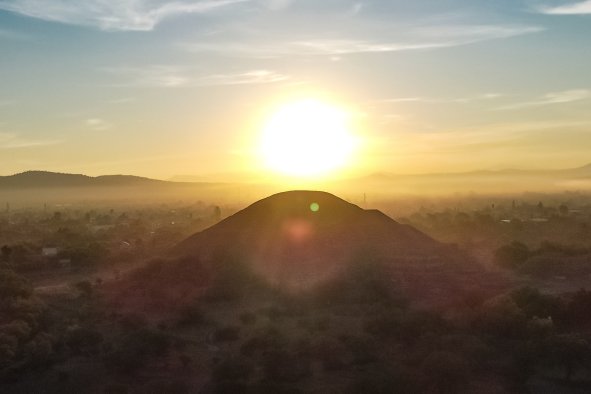Archaeologists have uncovered dozens of ancient Egyptian tombs and numerous artifacts, including a remarkable set of objects made from gold foil.
An Egyptian archaeological mission coordinated by the Supreme Council of Antiquities unearthed 63 mud-brick tombs and some simple burials at the Tel el-Deir necropolis in New Damietta, a Mediterranean coast city in the country's north.
The tombs are thought to date to ancient Egypt's Late Period, which lasted from 664 to 332 B.C., the country's Ministry of Tourism and Antiquities announced in a statement.
Among these, researchers uncovered a "huge" tomb containing burials of people who appear to have been of high social class. Inside, archaeologists found a collection of gold foil artifacts in a variety of different forms, such as those shaped like religious symbols or figures.
The archaeological mission also uncovered a pottery vessel containing dozens of bronze coins from the later Ptolemaic era during the excavation, as well as a group of local and imported ceramic artifacts. The latter shed light on trade links between the ancient city of Damietta and other settlements along the Mediterranean coast.
The Ptolemaic era began following Alexander the Great's conquest of Egypt—then controlled by the Persians—in 332 B.C. A Hellenistic polity known as the Ptolemaic Kingdom was subsequently established in 305 B.C. and ruled Egypt until 30 B.C., when the region was conquered by the Romans.
Another intriguing find during the excavation in New Damietta was ushabti statuettes, small figurines used in ancient Egyptian funerary practices. They were placed in tombs in the belief that they would act as servants for the deceased in the afterlife.
The layout of the newly discovered tombs at Tel el-Deir has been seen in other ancient Egyptian tombs of the Late Period, the ministry said.
Mohamed Ismail Khaled, secretary-general of the Supreme Council of Antiquities, the latest discoveries at the Tel el-Deir necropolis highlight the fact that ancient Damietta was a center of foreign trade during different historical eras.
Earlier this month, archaeologists announced that a collection of ancient Egyptian artworks and inscriptions had been uncovered hidden below the waters of the Nile.
A joint Egyptian-French archaeological mission identified works in an area of the iconic river, near the city of Aswan, the Ministry of Tourism and Antiquities said in a statement.
The settlement that existed in this location in ancient times was strategically significant, marking the southern frontier of pharaonic Egypt.
Do you have a tip on a science story that Newsweek should be covering? Do you have a question about archaeology? Let us know via science@newsweek.com.
Disclaimer: The copyright of this article belongs to the original author. Reposting this article is solely for the purpose of information dissemination and does not constitute any investment advice. If there is any infringement, please contact us immediately. We will make corrections or deletions as necessary. Thank you.




